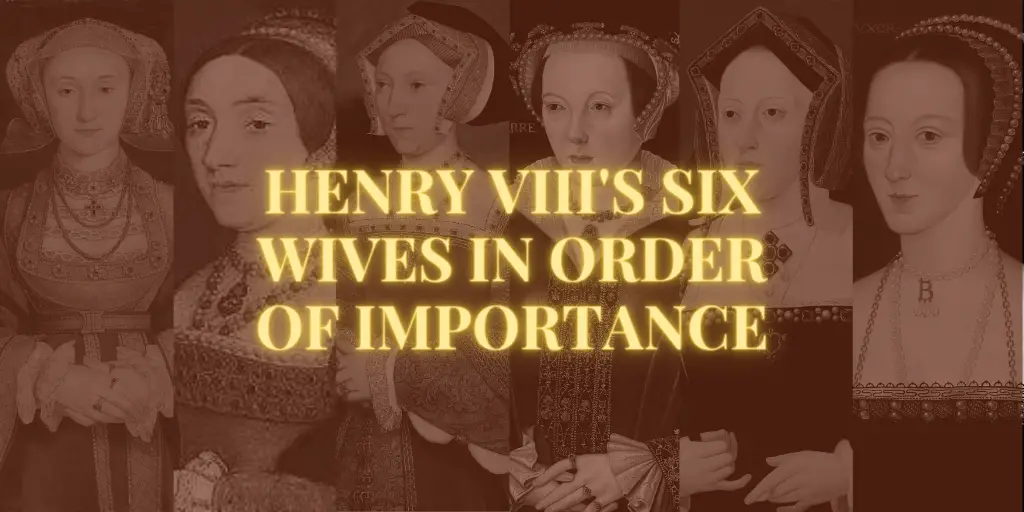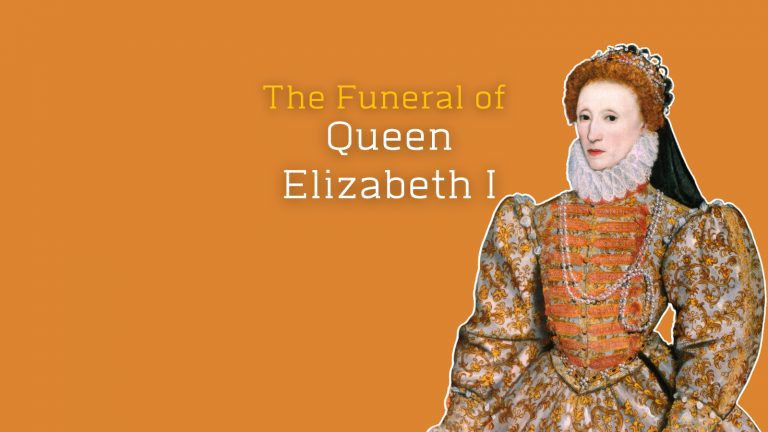Henry VIII’s wives in order of importance
[et_pb_section fb_built=”1″ _builder_version=”4.7.7″ _module_preset=”default” width=”99.9%”][et_pb_row _builder_version=”4.7.7″ _module_preset=”default”][et_pb_column type=”4_4″ _builder_version=”4.7.7″ _module_preset=”default”][et_pb_image src=”http://historywithhenry.com/wp-content/uploads/2021/08/The-Wives-of-Henry-VIII-in-Order-of-Marriage-1.png” title_text=”The Wives of Henry VIII in Order of Marriage (1)” _builder_version=”4.7.7″ _module_preset=”default”][/et_pb_image][et_pb_text _builder_version=”4.7.7″ _module_preset=”default”]
Everyone knows King Henry VIII’s wives in order of marriage (at least they should.)
But which of the wives was the most important?
Which wife played the greatest significance in history?
Yes, this may be an unchivalrous post, but here are the six wives of Henry VIII in descending order of importance.
The question is, do you agree?
[/et_pb_text][/et_pb_column][/et_pb_row][et_pb_row _builder_version=”4.7.7″ _module_preset=”default”][et_pb_column type=”4_4″ _builder_version=”4.7.7″ _module_preset=”default”][et_pb_text _builder_version=”4.7.7″ _module_preset=”default” header_2_text_color=”#7e0f82″]
Number 6 – Anne of Cleves
[/et_pb_text][/et_pb_column][/et_pb_row][et_pb_row column_structure=”1_3,2_3″ _builder_version=”4.7.7″ _module_preset=”default”][et_pb_column type=”1_3″ _builder_version=”4.7.7″ _module_preset=”default”][et_pb_image src=”http://historywithhenry.com/wp-content/uploads/2021/01/Anne_of_Cleves_by_Hans_Holbein_the_Younger-224×300.jpg” alt=”Henry VIII’s wives” title_text=”Henry VIII’s wives” _builder_version=”4.7.7″ _module_preset=”default”][/et_pb_image][/et_pb_column][et_pb_column type=”2_3″ _builder_version=”4.7.7″ _module_preset=”default”][et_pb_text _builder_version=”4.7.7″ _module_preset=”default”]
Coming in at last place is poor Anne of Cleves. I say “poor” many might argue that she had the best deal of the lot.
She was married to Henry for just 6 months before she agreed to disappear very quietly.
Her greatest claim to fame is that she was the wife that Henry likened to a horse.
“You have bought me a Flanders mare!” was his infamous quote.
The problem wasn’t Anne’s appearance at all. No other reports suggest that she had an equine appearance. The issue was that Henry was greatly offended at their first meeting.
[/et_pb_text][/et_pb_column][/et_pb_row][et_pb_row _builder_version=”4.7.7″ _module_preset=”default” custom_margin=”|1px||auto||”][et_pb_column type=”4_4″ _builder_version=”4.7.7″ _module_preset=”default”][et_pb_text _builder_version=”4.7.7″ _module_preset=”default”]
The marriage had been agreed with Anne’s brother, the Duke of Cleves, based on Henry viewing Holbein’s portrait of her. The two had never met in person before the marriage deal was struck. Hence Henry VIII didn’t really know what she looked like.
Anne arrived in England after being held up by bad weather in Calais. Henry decided that he would “surprise” her a day earlier than had been scheduled.
Henry rather liked dressing up and acting a bit of a fool.
On New Year’s day, Henry and five of his privy chamber dressed up as Robin Hood and his Merry Men. They burst in on Anne and her ladies. If this wasn’t enough a rather rotund “Robin” embraced her and planted a kiss firmly on her lips.
Henry’s idea was the Anne would magically recognise him and fall helplessly into his arms.
That didn’t happen.
Anne was shocked and annoyed by the display. Quite frankly, she didn’t have a clue what was happening. Poor Henry was forced to go away and change into more “kingly” attire and then return again and be introduced in a more regal fashion.
Both were probably highly embarrassed by the incident.
Henry never recovered from it and hence made up his idea of her not being beautiful!
Anne probably did get the best end of the deal. When Henry annulled their marriage, she got a string of castles and house in the way of settlement. She also outlived all the other wives, living to see Mary 1 crowned in Westminster Abbey.
Talking of Westminister Abbey, she does hold one accolade that all the other wives of Henry VIII do not. She is the only one buried in the Abbey.
[/et_pb_text][/et_pb_column][/et_pb_row][et_pb_row _builder_version=”4.7.7″ _module_preset=”default”][et_pb_column type=”4_4″ _builder_version=”4.7.7″ _module_preset=”default”][et_pb_video src=”https://www.youtube.com/watch?v=5cb-87pL9OQ” _builder_version=”4.7.7″ _module_preset=”default”][/et_pb_video][/et_pb_column][/et_pb_row][et_pb_row _builder_version=”4.7.7″ _module_preset=”default”][et_pb_column type=”4_4″ _builder_version=”4.7.7″ _module_preset=”default”][et_pb_text _builder_version=”4.7.7″ _module_preset=”default” header_2_text_color=”#7e0f82″]
Number 5 – Katherine Howard
[/et_pb_text][/et_pb_column][/et_pb_row][et_pb_row column_structure=”3_4,1_4″ _builder_version=”4.7.7″ _module_preset=”default”][et_pb_column type=”3_4″ _builder_version=”4.7.7″ _module_preset=”default”][et_pb_text _builder_version=”4.7.7″ _module_preset=”default”]
However you wish you spell Katherine; Catherine; Katheryn, Katherine Howard’s place in the order of importance is the same as her place in the order of wives – fifth.
Katherine was a lady in waiting to Anne of Cleves. It was in this role that she first captured Henry’s eye.
[/et_pb_text][/et_pb_column][et_pb_column type=”1_4″ _builder_version=”4.7.7″ _module_preset=”default”][et_pb_image src=”http://historywithhenry.com/wp-content/uploads/2021/01/HowardCatherine02.jpeg” alt=”Henry VIII’s wives” title_text=”Henry VIII’s wives” _builder_version=”4.7.7″ _module_preset=”default”][/et_pb_image][/et_pb_column][/et_pb_row][et_pb_row _builder_version=”4.7.7″ _module_preset=”default”][et_pb_column type=”4_4″ _builder_version=”4.7.7″ _module_preset=”default”][et_pb_text _builder_version=”4.7.7″ _module_preset=”default”]
It is safe to say that it probably wasn’t a match made in heaven for pretty Katherine.
However, Thomas Culpeper, gentleman and the King’s privy chamber, young, dashing and handsome. A far more suitable match.
And so it came to pass.
Young and naive Katherine certainly was. She was lead down the road to corruption by Lady Rochford who help facilitate meetings between the two. It still remains a mystery what Rochford’s motivation for this was. What did she hope to gain by it? We will never know.
Such was the laxity of care in these clandestine meetings that people around court soon started whispering. Then, there were rumours of Katherine Howard’s past. Important people began investigating.
When Henry went to the Chapel Royal at Hampton Court one morning and found an anonymous note on his pew listing the queen’s misdemeanours, it was the end for Katherine Howard.
Henry showed his vindictive side with style! The law was changed so that it became illegal to have “knowledge” of a queen before her marriage to the king. This meant that Katherine’s past caught up with her and a certain Francis Dereham.
They had a relationship in the past and even went as far as calling each other man and wife.
Both Dereham and Culpeper were executed on December 10th, 1541. Culpeper’s sentence was commuted by the king to a mere beheading. At the same time, Dereham had to suffer the full horrors of a traitor’s death.
Henry’s wrath didn’t end there, though. Lady Rochford had been driven mad by her imprisonment over the matter. The law was once again changed, this time allowing insane people to be executed. She followed Katherine Howard to the block.
Unlike Anne Boleyn, there was no swordsman for Katherine Howard. The night before her death, Katherine asked that the block be brought to her room so that she might practice laying her head on it.
The very next day, she did just that, and her place in history was sealed.
[/et_pb_text][/et_pb_column][/et_pb_row][et_pb_row _builder_version=”4.7.7″ _module_preset=”default”][et_pb_column type=”4_4″ _builder_version=”4.7.7″ _module_preset=”default”][et_pb_video src=”https://www.youtube.com/watch?v=AoLAHq3SDEY” _builder_version=”4.7.7″ _module_preset=”default”][/et_pb_video][/et_pb_column][/et_pb_row][et_pb_row _builder_version=”4.7.7″ _module_preset=”default”][et_pb_column type=”4_4″ _builder_version=”4.7.7″ _module_preset=”default”][et_pb_text _builder_version=”4.7.7″ _module_preset=”default” header_2_text_color=”#7e0f82″]
Number 4 – Jane Seymour
[/et_pb_text][/et_pb_column][/et_pb_row][et_pb_row column_structure=”2_3,1_3″ _builder_version=”4.7.7″ _module_preset=”default”][et_pb_column type=”2_3″ _builder_version=”4.7.7″ _module_preset=”default”][et_pb_text _builder_version=”4.7.7″ _module_preset=”default” hover_enabled=”0″ sticky_enabled=”0″]
Some might think that Jane Seymour, the wife Henry VIII is buried alongside might feature higher up this list. But Jane’s significance to history doesn’t feature prominently as some of Henry VIII’s other wives.
She was, of course, the mother of Edward VI, the long-awaited son of Henry VIII.
It was bringing Edward into the world that caused her own death, she died of post-childbirth complications on 24th October 1537 at Hampton Court.
But apart from that….
Well…?
[/et_pb_text][/et_pb_column][et_pb_column type=”1_3″ _builder_version=”4.7.7″ _module_preset=”default”][et_pb_image src=”http://historywithhenry.com/wp-content/uploads/2021/01/Hans_Holbein_the_Younger_-_Jane_Seymour_Queen_of_England_-_Google_Art_Project-scaled.jpg” alt=”Henry VIII’s wives” title_text=”Henry VIII’s wives” _builder_version=”4.7.7″ _module_preset=”default”][/et_pb_image][/et_pb_column][/et_pb_row][et_pb_row _builder_version=”4.7.7″ _module_preset=”default”][et_pb_column type=”4_4″ _builder_version=”4.7.7″ _module_preset=”default”][et_pb_text _builder_version=”4.7.7″ _module_preset=”default”]
Jane wasn’t one to shout about her accomplishments. After marriage to Anne Boleyn, this was one of the principal attractions that Henry had about her.
She probably made steps in reconciling Henry’s daughter Mary to him. Still, other than that, little is said about her involvement in matters of national importance. The only time she did, when she asked for pardons for those involved in the Pilgrimage of Grace Henry reminded her of the fate of her predecessor who “meddled in his affairs.”
That probably was enough for her to keep her views to herself.
Yet, it seemed that Henry did hold a high degree of affection for her. After her death, he wore black for three months. He didn’t remarry for two years… a long time for Henry VIII.
[/et_pb_text][/et_pb_column][/et_pb_row][et_pb_row _builder_version=”4.7.7″ _module_preset=”default”][et_pb_column type=”4_4″ _builder_version=”4.7.7″ _module_preset=”default”][et_pb_video src=”https://www.youtube.com/watch?v=n2EYH5x13Kk” _builder_version=”4.7.7″ _module_preset=”default”][/et_pb_video][/et_pb_column][/et_pb_row][et_pb_row _builder_version=”4.7.7″ _module_preset=”default”][et_pb_column type=”4_4″ _builder_version=”4.7.7″ _module_preset=”default”][et_pb_text _builder_version=”4.7.7″ _module_preset=”default” header_2_text_color=”#7e0f82″]
Number 3 – Catherine Parr
[/et_pb_text][/et_pb_column][/et_pb_row][et_pb_row column_structure=”1_3,2_3″ _builder_version=”4.7.7″ _module_preset=”default”][et_pb_column type=”1_3″ _builder_version=”4.7.7″ _module_preset=”default”][et_pb_image src=”http://historywithhenry.com/wp-content/uploads/2021/01/Catherine_Parr_from_NPG-scaled.jpg” alt=”Henry VIII’s wives” title_text=”Henry VIII’s wives” _builder_version=”4.7.7″ _module_preset=”default”][/et_pb_image][/et_pb_column][et_pb_column type=”2_3″ _builder_version=”4.7.7″ _module_preset=”default”][et_pb_text _builder_version=”4.7.7″ _module_preset=”default”]
We are getting towards the business end of this list of Henry VIII’s wives now. At this point, there could be good arguments made for any of the remaining three candidates.
Interestingly Catherine Parr is the wife that runs Henry close in terms of the number of marriages. Henry was husband number three for Catherine, having already been widowed twice over. She then, rather scandalously remarried six months after the death of the king, to Thomas Seymour. Seymour was the man she wanted to marry when Henry came courting. In one of the wiser decisions he made in his life, Seymour decided that he would take a step back and allow Henry to make his move.
[/et_pb_text][/et_pb_column][/et_pb_row][et_pb_row _builder_version=”4.7.7″ _module_preset=”default”][et_pb_column type=”4_4″ _builder_version=”4.7.7″ _module_preset=”default”][et_pb_text _builder_version=”4.7.7″ _module_preset=”default”]
Catherine Parr has a string of significant accomplishments to her name.
She was a highly educated woman and was a significant reformer in matters of religion. She read illegal books and often shared these texts with her ladies. This attitude to religion brought her into conflict with some of the traditionalists in Henry’s council like Bishop Stephen Gardiner.
The traditionalists wanted Catherine out. After a disagreement with Henry where she offered a conflicting opinion on religion in front of others, they believed they had their chance. Henry even authorised an arrest warrant to be drawn up. However, news of this was passed back to Catherine. She managed to reconcile with her husband by promising not to question him again. When the arrest warrant was presented to the queen the following day by the Lord Chancellor, Henry attacked him and sent him on his way.
This matter is often underplayed in terms of its significance. But it represents the pinnacle of the battle that was occurring between the traditionalists in Henry’s council and the reformers. In short, the reformers won. In many ways, this was thanks to Catherine Parr. If Catherine had not reconciled with the king, then today we may have been writing about seven of Henry VIII’s wives and not six!
Catherine Parr was also a published author. “Prayers or Meditations” was written in 1545 and was the first book published by a woman in England under her own name and in the English language. She also wrote the rather catchy titled, “The lamination of a sinner” which was published after Henry VIII’s death.
Catherine Parr was one of only two wives to be made Regent of England. This happened when Henry went on his final campaign to France between July and September of 1544. She ruled England as she saw fit for those short months, providing an example to her stepdaughter Elizabeth.
Talking of Elizabeth…
This may outrage some people, but Catherine Parr was effectively Elizabeth’s mother. Anne Boleyn was executed before Elizabeth had turned three. It was doubtful that Elizabeth even remembered her. However, Catherine Parr took great interest in her stepdaughter, and the two were incredibly close. In fact, after Henry’s death, Elizabeth lived with Catherine Parr. There is no doubt that Catherine helped educate and heavily influence Elizabeth in her thinking and leadership and statecraft style.
[/et_pb_text][/et_pb_column][/et_pb_row][et_pb_row _builder_version=”4.7.7″ _module_preset=”default”][et_pb_column type=”4_4″ _builder_version=”4.7.7″ _module_preset=”default”][et_pb_video src=”https://www.youtube.com/watch?v=OvfiU0fej_E” _builder_version=”4.7.7″ _module_preset=”default”][/et_pb_video][/et_pb_column][/et_pb_row][et_pb_row _builder_version=”4.7.7″ _module_preset=”default”][et_pb_column type=”4_4″ _builder_version=”4.7.7″ _module_preset=”default”][et_pb_text _builder_version=”4.7.7″ _module_preset=”default” header_2_text_color=”#7e0f82″]
Number 2 – Catherine of Aragon
[/et_pb_text][/et_pb_column][/et_pb_row][et_pb_row column_structure=”2_5,3_5″ _builder_version=”4.7.7″ _module_preset=”default”][et_pb_column type=”2_5″ _builder_version=”4.7.7″ _module_preset=”default”][et_pb_image src=”http://historywithhenry.com/wp-content/uploads/2021/01/Catalina_de_Aragón_por_un_artista_anónimo.jpg” alt=”Henry VIII’s wives” title_text=”Henry VIII’s wives” _builder_version=”4.7.7″ _module_preset=”default”][/et_pb_image][/et_pb_column][et_pb_column type=”3_5″ _builder_version=”4.7.7″ _module_preset=”default”][et_pb_text _builder_version=”4.7.7″ _module_preset=”default”]
Catherine of Aragon is a hugely significant figure in the pages of English history.
She had first married Henry’s elder brother, Arthur Tudor, Prince of Wales.
She was married to Henry for over twenty years. Far longer than the other five wives combined.
She gave Henry his first male heir. A fact that is so often overlooked by history. On the 1st January 1511, she gave birth to a son, Henry, Duke of Cornwall. Henry VIII’s heir. It was a moment of national celebration. Cannon were fired from the Tower of London, the city bells were run, bonfires were lit, and even wine was given to the people to toast the baby’s head. However, young Henry died just 52 days later. The reasons for the child’s death are not clear.
[/et_pb_text][/et_pb_column][/et_pb_row][et_pb_row _builder_version=”4.7.7″ _module_preset=”default”][et_pb_column type=”4_4″ _builder_version=”4.7.7″ _module_preset=”default”][et_pb_text _builder_version=”4.7.7″ _module_preset=”default”]
On the 11 June 1513, Catherine was appointed Regent of England when the king went on his first campaign in France. While Henry won a minor battle, the Battle of the Spurs, Catherine was masterminding victory in a far more significant engagement.
Taking advantage of Henry’s absence, the Scots invaded England. Summoning up memories of her mother, Isabelle of Castile at the siege of Grenda, Catherine rode north to address the troops in full armour. While she left command of the frontline army to Thomas Howard, she commanded the reserve troops.
The English won a deceive victory at the battle of Flodden. The Scottish King Jame IV was killed, and his body captured. For a while, she toyed about sending the body to Henry as a gift but instead settled for a piece of his bloodied coat.
To put the victory at the Battle of Flodden into context; it was the largest ever battle between England and Scotland. Over 1500 English troops were killed, and the estimates at the number of Scots killed rank between 5000 and 17,000.
Catherine of Aragon was mother to Mary I of England. Mary was the first woman to sit on the throne of England. Okay, she got herself the somewhat notorious nickname of Bloody Mary. But there is little doubt that she would have never have sat on the throne if she didn’t display the resolve and tenacity of her mother.
It was that resolve and tenacity that helped shape the country England is today.
If, when Henry VIII decided he wanted a divorce, Catherine of Aragon had gone quietly, then we might never have had the break from the Rome, the reformation or the dissolution of the monasteries.
Instead, Catherine of Aragon decided to fight. Not just for herself, but for her daughter Mary’s rights to be recognised as the true heir to the throne.
She played every trick in the book. At the opening of the Papal Commission that tried the validity of the marriage, she threw herself at Henry’s feet and asked how she had displeased him. After securing every sympathy from those present and thoroughly embarrassing the king, she promptly turned and left the building, refusing to take any further part in the proceedings.
The failure of the Papal Commission caused the downfall of Henry’s chief minister, Cardinal Wolsey. However, Wolsey’s downfall led to Thomas Cromwell’s appointment, who brought forward the idea of a break from Rome.
Even after the annulment of her marriage by Archbishop Thomas Cranmer and Henry’s marriage to her nemesis, Anne Boleyn, she refused to admit defeat. Even when banished to Kimbolton Castle, she refused to accept being addressed as anything other than queen.
Catherine of Aragon finally died on 7th January 1536. Henry VIII and Anne “celebrated” by dressing up in yellow.
But even as her death came near, she refused to accept she was nothing less than Henry VIII’s wife. Her final letter, written in December 1535 is heartbreaking stuff.
[/et_pb_text][/et_pb_column][/et_pb_row][et_pb_row _builder_version=”4.7.7″ _module_preset=”default”][et_pb_column type=”4_4″ _builder_version=”4.7.7″ _module_preset=”default”][et_pb_text _builder_version=”4.7.7″ _module_preset=”default” background_enable_color=”off” custom_padding=”|4px||4px|false|false” box_shadow_style=”preset5″ box_shadow_horizontal=”1px” box_shadow_color=”#E02B20″]
My most dear lord, king and husband,
The hour of my death now drawing on, the tender love I owe you forceth me, my case being such, to commend myself to you, and to put you in remembrance with a few words of the health and safeguard of your soul which you ought to prefer before all worldly matters, and before the care and pampering of your body, for the which you have cast me into many calamities and yourself into many troubles. For my part, I pardon you everything, and I wish to devoutly pray God that He will pardon you also. For the rest, I commend unto you our daughter Mary, beseeching you to be a good father unto her, as I have heretofore desired. I entreat you also, on behalf of my maids, to give them marriage portions, which is not much, they being but three. For all my other servants I solicit the wages due them, and a year more, lest they be unprovided for. Lastly, I make this vow, that mine eyes desire you above all things.
Katharine the Queen.
[/et_pb_text][/et_pb_column][/et_pb_row][et_pb_row _builder_version=”4.7.7″ _module_preset=”default”][et_pb_column type=”4_4″ _builder_version=”4.7.7″ _module_preset=”default”][et_pb_video src=”https://www.youtube.com/watch?v=CQgcsN2ABAc” _builder_version=”4.7.7″ _module_preset=”default”][/et_pb_video][/et_pb_column][/et_pb_row][et_pb_row _builder_version=”4.7.7″ _module_preset=”default”][et_pb_column type=”4_4″ _builder_version=”4.7.7″ _module_preset=”default”][et_pb_text _builder_version=”4.7.7″ _module_preset=”default” header_2_text_color=”#7e0f82″]
Number 1 Anne Boleyn
[/et_pb_text][/et_pb_column][/et_pb_row][et_pb_row column_structure=”3_5,2_5″ _builder_version=”4.7.7″ _module_preset=”default”][et_pb_column type=”3_5″ _builder_version=”4.7.7″ _module_preset=”default”][et_pb_text _builder_version=”4.7.7″ _module_preset=”default”]
Not only was Anne Boleyn the most important and significant of Henry VIII’s wives. She must surely rank as one of the most influential people in the last 1000 years of English history.
Unlike Catherine of Aragon, she wasn’t the daughter of monarchs. She was the daughter of a diplomat and a relativity minor member of the Howard dynasty; her mother was the Duke of Norfolk’s daughter. In fact, such was her seemingly insignificant status we don’t even know the year of her birth. We don’t know for sure if her sister, Mary Boleyn, was older or not. However, most historians believe that Anne was the younger of the two.
However, like many in the Tudor court, her status didn’t stop her from flying high.
[/et_pb_text][/et_pb_column][et_pb_column type=”2_5″ _builder_version=”4.7.7″ _module_preset=”default”][et_pb_image src=”http://historywithhenry.com/wp-content/uploads/2021/01/Anne_boleyn-scaled.jpg” alt=”Henry VIII’s wives” title_text=”Henry VIII’s wives” _builder_version=”4.7.7″ _module_preset=”default”][/et_pb_image][/et_pb_column][/et_pb_row][et_pb_row _builder_version=”4.7.7″ _module_preset=”default”][et_pb_column type=”4_4″ _builder_version=”4.7.7″ _module_preset=”default”][et_pb_text _builder_version=”4.7.7″ _module_preset=”default”]
Her first noted appearance at Henry VIII’s court was when she played “Perseverance” in a pageant thrown in for the Imperial ambassadors in 1522.
For an incredibly long period of seven years, she was courted by Henry VIII refusing at all times to become his mistress.
Henry was infatuated with her. He loved her wit, intelligence and forthright opinions. He loved the “pursuit.”
So much so that he moved heaven and earth (literally) to make her his wife.
Anne was crowned as queen consort on the 1st June 1533 at Westminster Abbey. She was the final queen consort to be crowned at a different time to her husband. And unlike any other queen consort, St Edward’s Crown was used for the occasion.
However, once Queen those qualities that attracted Henry to her in the first place became problematic. A queen should not be forceful or have strong opinions. Anne did. And she wasn’t afraid of showing them.
That, together with her “failure” to provide Henry with a son, proved to be her downfall. She miscarried a child after Henry’s final jousting accident. It was to be the final nail in the coffin.
Henry wanted rid of her, and he charged his chief minister Thomas Cromwell with the task.
Cromwell rose to the occasion in fine style. He knew another divorce would be bad for the king, so instead resorted to inventing other reasons Henry could use.
On the 2nd of May 1536, Anne Boleyn was arrested and sent by barge to the Tower of London. Her alleged crimes; adultery, incest and treason.
By modern standards the charges were ludicrous. However, the King got what the king wanted. On 15th May she was found guilty.
Was executed on Tower Green on the 19th May 1536. The executioner from Saint-Omer in France, an expert swordsman, had been shipped over for the task. It was strange that he managed to arrive in time, considering the verdict only occurred four days earlier. A suspicious person might suggest that he had been summoned before the verdict had even been delivered.
Her bravery and dignity at her execution are well documented. As was her failure to admit to any of the crimes she had been found guilty of at her final confession.
Her final speech on the scaffold was taken down with amazing accuracy:
Good Christian people, I am come hither to die, for according to the law, and by the law I am judged to die, and therefore I will speak nothing against it. I am come hither to accuse no man, nor to speak anything of that, whereof I am accused and condemned to die, but I pray God save the king and send him long to reign over you, for a gentler nor a more merciful prince was there never: and to me he was ever a good, a gentle and sovereign lord. And if any person will meddle of my cause, I require them to judge the best. And thus I take my leave of the world and of you all, and I heartily desire you all to pray for me. O Lord have mercy on me, to God I commend my soul.
After her death, Henry VIII tried to remove all trace of her. He portraits were taken down and destroyed; even the famous picture of her with the B necklace isn’t contemporary. The initials H&A carved into every royal palace were removed.
But there was one thing Henry couldn’t remove.
Twenty-two years later, Anne Boleyn’s daughter, Elizabeth, became Queen.
Quite possibly the greatest monarch to sit on the throne of England.
Without Anne, that would never have happened.
Anne Boleyn, the most important of Henry VIII’s wives? Almost certainly.
[/et_pb_text][/et_pb_column][/et_pb_row][et_pb_row _builder_version=”4.7.7″ _module_preset=”default”][et_pb_column type=”4_4″ _builder_version=”4.7.7″ _module_preset=”default”][et_pb_video src=”https://www.youtube.com/watch?v=LYIb26xFNMk” _builder_version=”4.7.7″ _module_preset=”default”][/et_pb_video][/et_pb_column][/et_pb_row][et_pb_row _builder_version=”4.7.7″ _module_preset=”default”][et_pb_column type=”4_4″ _builder_version=”4.7.7″ _module_preset=”default”][et_pb_pricing_tables show_bullet=”off” featured_table_price_background_color=”#E02B20″ _builder_version=”4.7.7″ _module_preset=”default” price_font=”|800|||||||” price_font_size=”58px”][et_pb_pricing_table title=”Henry VIII’S WIVES IN ORDER” sum=”MARRIAGE” _builder_version=”4.7.7″ _module_preset=”default” sticky_transition=”on”]
1. Catherine of Aragon
2. Anne Boleyn
3. Jane Seymour
4. Anne of Cleves
5. Katherine Howard
6. Katherine Parr
[/et_pb_pricing_table][et_pb_pricing_table title=”HENRY’S WIVES IN ORDER” sum=”IMPORTANCE” _builder_version=”4.7.7″ _module_preset=”default” sticky_transition=”on”]
6. Anne of Cleves
5. Katherine Howard
4. Jane Seymour
3. Katherine Parr
2. Catherine of Aragon
1. Anne Boleyn
[/et_pb_pricing_table][/et_pb_pricing_tables][/et_pb_column][/et_pb_row][/et_pb_section]






